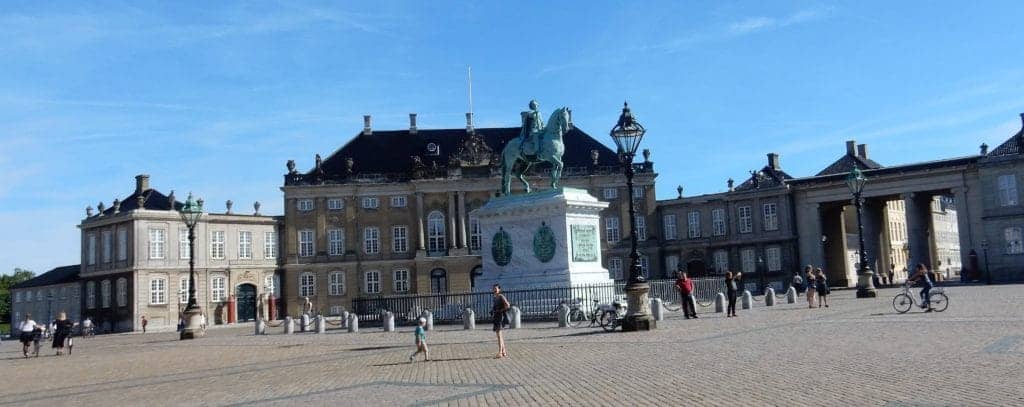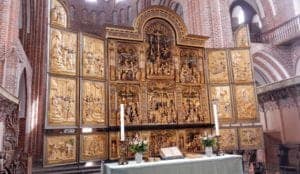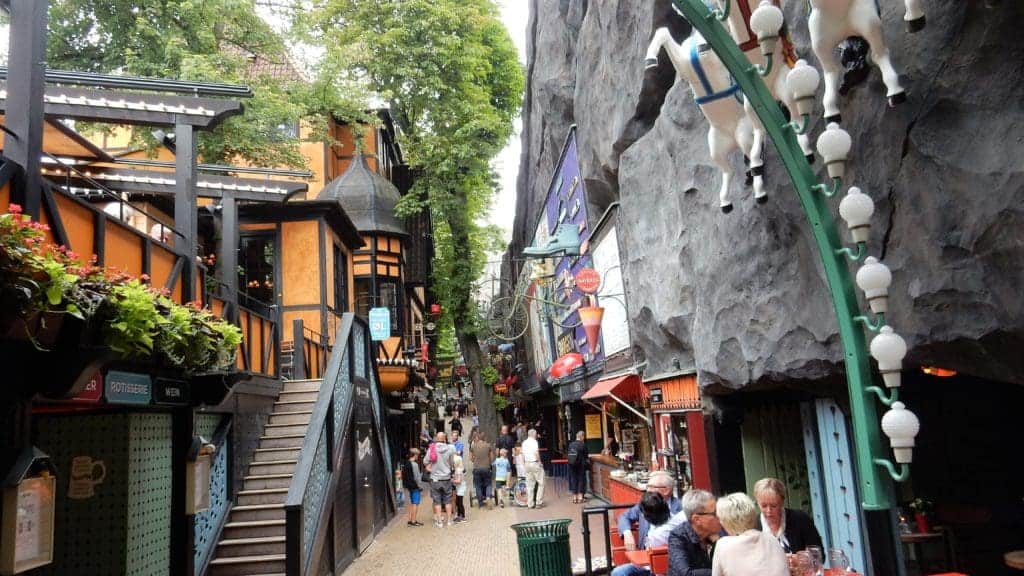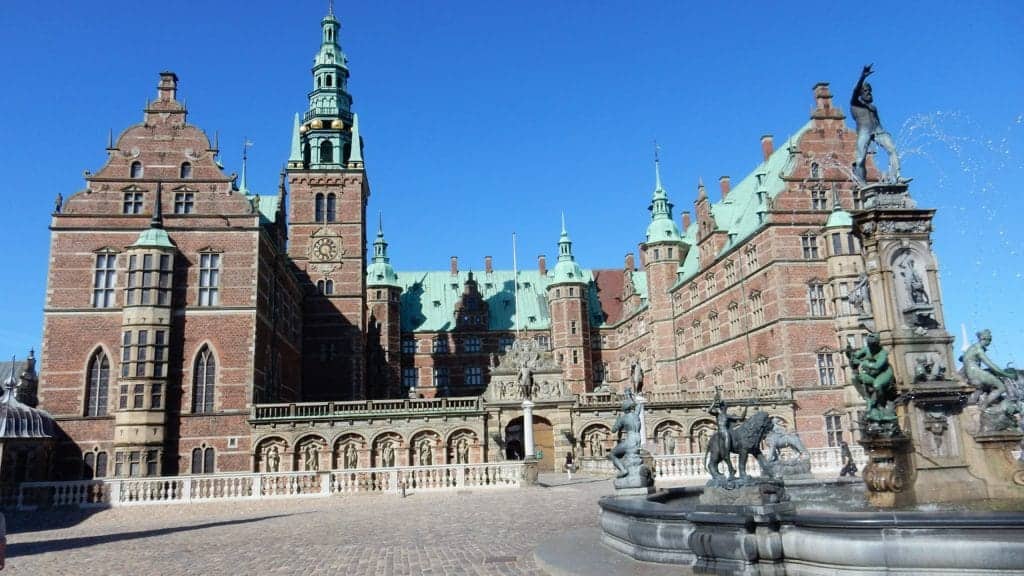Castles, Palaces & Gardens and More
Castles, Palaces & Gardens
Denmark has a lot of fascinating castles and palaces, called “slots” and many of them seem to have extremely large and elaborate gardens which are available to the public. Mike and I have been in quite few during this trip with the majority being within an hour of Copenhagen. Fredensborg Palace is where the royal family spend six months in the spring and autumn every year. Part of the palace that is used by the Queen when entertaining guests is open to the general public for a month every July. We went expecting a short visit and ended up spending hours there. The gardens cover about 300 acres with about 20 acres being private. Even the private gardens are open if you were on a guided tour in July. During our tour we saw a large hall used to seat many guests at a Royal dinner. The tour guide said that people were surprised at how small the hall was. She then told us that it was actually about 50 feet x 50 feet. That is 2500 square feet which is larger than our first four bedroom house and it just looked like a fairly normal large room. I couldn’t believe it so I counted the tiles and she was correct. It is just amazing what an outrageously high ceiling can do to your impression of a room.

A few days earlier we had visited the Amelienborg Palace in the heart of Copenhagen which is composed of four externally identical mansions that used to belong to four noble families. When the existing palace was burned down in a fire in 1794 the royal family purchased all four homes that form an octagonal square (interesting term). I believe that one of the four buildings is the main residence for the Queen of Denmark. The Crown Prince lives in another one. Another is a guest castle also used for public gala events and the last one is used for administration. The square in the middle was wide open when we visited and I think it is open to the public all the time, even when the Queen is in residence although there are more guards around then. Near Amelienborg is the Rosenborg Castle which is now open as a museum. We toured both these castles in one day. The Rosenborg Castle is where the main crown jewels are kept. Most of the old castles are now museums and not royal residences.
We did go to see the outside of Kronborg Castle in Helsingor which is famous as the castle from Macbeth. The last castle we visited in Denmark was the Frederiksborg Castle in Hillerod. It is another one of the castles with phenomenal grounds that I believe are open without charge to the public. Although we didn’t go inside Mike and I were both extremely impressed with the architecture and look of this castle as well as with the gardens (see the photo at the top of this article). Overall Denmark has a lot of parks and green spaces for people to relax including inside the city itself.
 In addition to castles we have toured a lot of churches and cathedrals. The architecture and the sculptures and décor inside them can be fascinating. Many of the cathedrals and castles were built from bricks and have a similar look to them. Today we happened across Roskilde Cathedral which was built over one thousand years ago when bricks where first introduced to Denmark although it has had many additions and modifications since then. The most recent addition was completed in 1995. This cathedral has been the main burial site for Danish monarchs since the 15th century. Some of the royal caskets with their sculptures are just stunning. After forty years of visiting European churches I am finally getting used to walking on top of bodies buried right under the walk ways.
In addition to castles we have toured a lot of churches and cathedrals. The architecture and the sculptures and décor inside them can be fascinating. Many of the cathedrals and castles were built from bricks and have a similar look to them. Today we happened across Roskilde Cathedral which was built over one thousand years ago when bricks where first introduced to Denmark although it has had many additions and modifications since then. The most recent addition was completed in 1995. This cathedral has been the main burial site for Danish monarchs since the 15th century. Some of the royal caskets with their sculptures are just stunning. After forty years of visiting European churches I am finally getting used to walking on top of bodies buried right under the walk ways.
Tivoli Gardens:
Mike wanted to go and see Tivoli Gardens which is an amusement park right in the centre of Copenhagen. Tivoli Gardens opened in 1843 and is the second-oldest operating amusement park in the world. The oldest is also in Denmark. In 1943, Nazi sympathisers burnt many of Tivoli’s buildings, including its concert hall, to the ground but the park was back in operation after just a few weeks. There is a wooden roller coaster there that is one of the oldest in the world still in operation. It was built in 1914. Although individual visits to Tivoli are not inexpensive apparently a season pass isn’t too high. This allows the locals access to all sorts of concerts and entertainment that occur in the evenings during the summer for no extra charge. I think that is a good system. Tivoli looks like it has tried to maintain somewhat of a historic atmosphere while providing extremely modern rides. There are also multiple theatres on the grounds. It was worth a visit even if we didn’t go on any of the rides. It is not as large as the CNE or Canada’s Wonderland. Overall it is quite compact but manages to pack a lot into a small space.

Christiania: Free City
Copenhagen as a city has a lot of really interesting areas. One that is more than a little different is Freetown Christiania inside Copenhagen. Christiania is quite the contrast to its neighbor Christianshavn which is a high end exclusive area. In 1971 a group of hippies occupied an abandoned military base and developed their own rules independent of the government. Christiania existed under special conditions for 40 years with lots of conflicts with the state and police. Five years ago an agreement was reached with the government. It has a semi-legal status as a city within a city. Marijuana has always been sold openly here. Last year there was a violent crime where three people, including a police officer, where killed. According to the internet Christiania was very unhappy about this violence and cleaned itself up somewhat and stopped selling marijuana and asked it residents to buy it elsewhere. If this is true then it didn’t last very long. When we were there marijuana was sold openly in many kiosks. There are signs that we missed initially that state that there is a strict no-photography rule in Christiania. Mike started to take some photos and was stopped. He was told that since it is illegal in Denmark to sell marijuana it wouldn’t be good to have people photographed “in the act” even though it is mostly tolerated by the police in Christiania. I will say that there are a lot of signs up against “hard” drugs. Christiania is still a modern day hippy commune with its cafes, handmade jewelry kiosks and marijuana stands. Many of the 1,000 residents are artisans who try to live as organically as possible. Cars have to be left outside the gates and there are signs when you enter that say “You are now leaving the European Union”. When you leave Christiania there is a sign that says “You are now entering the European Union”. All in all, an interesting and unique area for a very short visit.
These are just some of the unique things that we have seen and done while staying in this area. There are days when we are very tired at the end of the day. Many days we accomplished our 10,000 steps that we both aim for plus biked to and from Copenhagen which is about 6 km each way. What I don’t understand is why, if exercise is so good for you, we can hardly get up the steps into the RV at the end of the day because of stiff muscles. All in all we have enjoyed our time in Denmark. We will be leaving it tomorrow (Tuesday). I am going to try and post another article summarizing Denmark and our impressions assuming that I can find the time ?.


Leave a Reply